Bright light, sparkling costumes, beautiful music and the glide of dancers on the parquet ... Ballroom dancing, especially competitive performances, fascinate, delight and often cause a desire today to go to a dance school to learn this magnificence.
But not everyone knows that each of the dances has its own name, history and specifics, and a novice often can not distinguish between them. It is important to understand what types of ballroom dancing exist and why they are attractive.
To date, the generally accepted list is as follows:
European program
Slow or English waltz; his predecessor was the Boston Waltz. Incredibly beautiful pair dance, is executed on ¾, 3 steps are necessary for each step. It is filled with sensuality and tenderness, interesting contact partners who almost merge in the lower part of the body and stay at a distance in the upper.
Tango is a passionate vibrant pair dance that came from Argentina. It has a clear rhythm and close contact of partners, which is why for a long time I was in disgrace. The main movements are broad steps, turns and support.
Viennese Waltz - a quick version of the English waltz, has a more rapid pace of execution.
Foxtrot is a natural pair dance based on two movements - such as a step-feather and a change of direction. It is this type of ballroom dancing that allows judges to understand whether a couple can even dance.
Quickstep or Quick Foxtrot is a quick version of classic foxtrot.
Latin American Program
Samba is a passionate dance that combines the movements of African and European styles. Performed to the characteristic rhythm set by drums and maracas.
Cha-cha-cha - energetic Cuban dance, has a size of 4/4 and a pace of 30 beats / minute.
Rumba is a Cuban dance with a pronounced erotic touch. It is characterized by a rather slow pace, close contact of partners and broad steps.
Paso doble - Spanish dance; his movements imitate bullfighting. The division into roles is typical, often the partner depicts a torero, and the partner, depending on the scenario, depicts a cloak or mulelet (a piece of bright red fabric in his hands).
Jive is a bright energetic dance of African descent, characterized by quick jerky movements; on its basis boogie-woogie and twist arose.
Almost everyone loves ballroom dancing - which dances to choose? Each of them is beautiful in its own way, and it is worth starting from exclusively personal preferences; having mastered any of them, you will be able to recharge yourself with positiveness, perfectly control your body and, of course, lose weight. Internal stress, perfect posture and significant physical exertion are able to carve a magnificent figure with any source data.
There are only ten dances that are performed at competitions and championships in sports ballroom dancing. Ballroom dancing is divided into European and Latin American programs.
Ballroom dancing European program: slow waltz, tango, quickstep (fast foxtrot), slow foxtrot, Viennese waltz.
Ballroom dancing Latin American program: Paso doble, samba, rumba, cha-cha-cha, jive.
Amateur ballroom dancing combines the same elements as professional ones: entertainment, emotional stress. You can deal with them at any age, with any level of initial training. Regular ballroom dancing gives you the ability to move beautifully. The beauty of movement is pleasure and self-confidence. Clothing for ballroom dancing should be free enough and not restrict movements. Comfortable steady shoes for ladies: these are high-heeled shoes, at the initial stage and for warming up - soft slippers.
Types of ballroom dancing:
Viennese Waltz. The Viennese Waltz is a beautifully romantic ballroom dance. The only ballroom dance has the task of expressing feelings of glee, tender affection, respect and admiration through continuous rotation. Around the beginning of 1830, composers Frans Lanner and Johann Strauss wrote several, now very famous, waltzes of our era, thereby contributing to the development and popularity of this ballroom dance.
Jive. Jive is an international version of swing dance, currently the jive dance is performed in two styles. Jive is a very fast, energy-intensive ballroom dance. This is the last dance that is performed at competitions, and dancers must show that they are ready to perform it with great dedication. This is the fastest ballroom dance of all.
Quickstep Quickstep Ballroom Dance appeared during the 1st World War in a suburb of New York, originally performed by African dancers. Quickstep is a fun, fast, energetic ballroom dance that very effectively combines the playful character of lightning-fast jumps, kicks, turns, bends, poses and soft plastic dance pairs.
Slow waltz. Since the pace of the Viennese waltz was fast enough, soon composers began to write music, which was much slower. From this music evolved new style a waltz called Boston. Slow waltz is a slow lyrical ballroom dance with a characteristic pronounced and constantly repeating wave of surf, creating the impression of flight and weightlessness. A special appeal and expressiveness of this dance can provide a softer nature of the performance of reductions. Partner management is softly veiled, hidden.
Slow Foxtrot. Foxtrot is a ballroom dance that was born in the twentieth century and was named after the American singer Harry Fox. An unusually harmonious ballroom dance, combining previously unique sliding steps, airiness, lightness. Perhaps, only here both partners completely merge in the dance, as a whole. A truly unique, incomparable ballroom dance.
Paso doble. Dance of the Spanish gypsies. Dramatic French-Spanish flamenco style, where a man portrays a matador (brave man) in a fight with a bull, a lady portrays his cloak or bull. Paso doble is an emotional, explosive, heroic ballroom dance, where the plot resembles a variety of plots of bullfighting with the participation of a bullfighter, a bull and even a cloak. It features a special setting of the body, hands, head.
Rumba. Rumba ballroom dance originated in Cuba. Like a typical dance, has become a classic of all latin American dances. Rumba - a slow ballroom dance, characterized by feelings filled with love movements and gestures, has a Latin style of movement in the hips, is an interpretation of the relationship between a man and a woman.
Samba. The rhythmic national Brazilian samba dance is now confidently included in the program of modern ballroom dancing. Samba ballroom dance includes characteristic Latin movements of the hips. The most developed in terms of complexity of rhythms and an almost gentle separate figure is the dance in which the movements of the hips play a key role in generating rhythm.
Tango is a very soft ballroom dance in its movements, but it constantly and unexpectedly changes from restrained to assertive-aggressive. In a clear jerky rhythm of the dance, hands and head unexpectedly vary, above all. The partner's role in this ballroom dance is clearly dominant with a clear demonstration of excessive determination.
Cha-cha-cha. A fast, fun ballroom dance with strong hip movement and a characteristic knee rhythm. It is believed that carelessness and swagger are also characteristic of this dance.
Hearing the phrase “ballroom dancing”, many imagine luxurious dresses, exquisite men's tailcoats and quiet classical music. This is because the word "ball" is associated with solemn royal events and events, which we read about in children's tales.
In fact, “ballroom” began to be called secular, unprofessional, pair dances, which arose in the Middle Ages in Europe. Throughout their history, they have undergone significant changes, and each era has invested in them its own characteristics and specific features.
In the 20th century, ballroom dancing was made up of European dances, in which elements of Latin American and African culture were introduced. In fact, most of the modern ballroom trends have real African “roots” that were “polished” by European masters and dance schools.
The separation of ballroom dancing and new items that have become popular
In the twenties of the 19th century, a special Council arose under the British Imperial Society, which was supposed to be engaged specifically in ballroom dancing. The aim of the specialists was to standardize all the areas available at that time, such as:- foxtrot (fast and slow);
- waltz;
- tango.
Today, every year, thousands of large and small competitions in classical sports dancing are held. In most cases, they are divided into three programs - Latin American, European, and the "top ten."
Everything you need to know about ballroom dancing
The first feature of ballroom dancing is that they are all paired, and represent a kind of “communication” between a lady and a gentleman. Moreover, partners must strictly observe all acceptable contact points in order to truly merge in an excellent, beautiful, charming look, dance. Techniques developed over the years have been brought to the perfect balance so that the dance is not just movements to the music, but a combination of harmonious steps creating the perfect ensemble.If we talk about contacts, then Latin American dances are more freedom of movement, and the partners most of the time they touch only with their hands. At some points, contact is completely lost, and sometimes intensifies, during the execution of special figures.
In the modern world, the popularity of ballroom dancing has declined significantly, due to the fact that their performance requires special skills and grueling training to constantly maintain shape.
In the sixties of the 20th century, a twist appeared, the popularity of which became the “beginning of the end” for pair dance styles. Tango, waltz, foxtrot have almost sunk into the summer and have ceased to serve as a way of entertainment for the masses of people.
Without a doubt, talking about ballroom dancing as one direction is wrong - each of them has its own characteristics that deserve special attention. But undoubtedly, the most harmonious and bright are two dances - tango and foxtrot. In one period of time, they managed to cover several continents at once, and to this day they remain popular and favorite destinations of millions of people around the world.
Tango
This style appeared in the African communities living in Buenos Aires, and was based on ancient dance movesinvented by the inhabitants of the hottest continent.
Touring orchestras and dancers "brought" him to Europe, and for the first time he was performed in the capital of France - Paris, and only after that he "went" to Berlin, London and other cities.
In 1913, dance became popular in Finland, the USA and many other countries.
During the period of the "Great Depression" there was a real "golden age" of tango - at this time many ensembles were created, which included ordinary peoplethat have become real stars over time.
In 83 of the 20th century, Forever Tango was created in New York, after the shows of which people around the world began to go to school in order to master this beautiful, rhythmic and passionate direction.
Foxtrot
There is an erroneous opinion that this dance owes its name english word "Foxtrot", which in translation means "fox walk," however, in fact, the name comes from the name of the person who became the ancestor of the style - Harry Fox.
Appearing in the USA in 1912, the foxtrot immediately after the First World War won the hearts of Europeans.
A feature of this dance was the “weightlessness” of steps, which gave all movements a special lightness and airiness. Perhaps no more “ballistic” direction can boast that partners, in the process, become literally one whole, merge into an ideal organism.
Ballroom Dance Classification
All ballroom dance Sport are divided into two main programs - Latin American and European. Each of the directions has certain norms, rules and pace, which must be followed.Latin American includes such styles as:
- cha-cha-cha (from 30 to 32 beats per minute);
- jive (from 42 to 44 beats per min.);
- paso doble (from 60 to 62 cycles per min.);
- rumba (from 25 to 27 beats per minute);
- samba (from 50 to 52 measures per min.).
- tango (from 31 to 33 beats per minute);
- slow waltz (from 28 to 30 beats per minute);
- quickstep (from 50 to 52 beats per minute);
- slow foxtrot (from 28 to 30 beats per minute);
- viennese waltz (from 58 to 60 beats per minute).
Ballroom dance, as a form of art, sport or active leisure, continues to cause interest among many people from different countries and nationalities. There is a lot of ballroom dancing, but only 10 of them have gained worldwide popularity. These dances are included in the international dance program with the uniform requirements for their performance.
See how many of the following dances are familiar to you.
Slow waltz
Waltz is the most airy and light because of the glide ballroom dance belonging to the European dance group. The dance is characterized by long, smooth movements, continuous turns, as well as ups and downs. The dance is very elegant and elegant, from the side it seems that the dancers move on the parquet easily, almost without effort.
Viennese Waltz
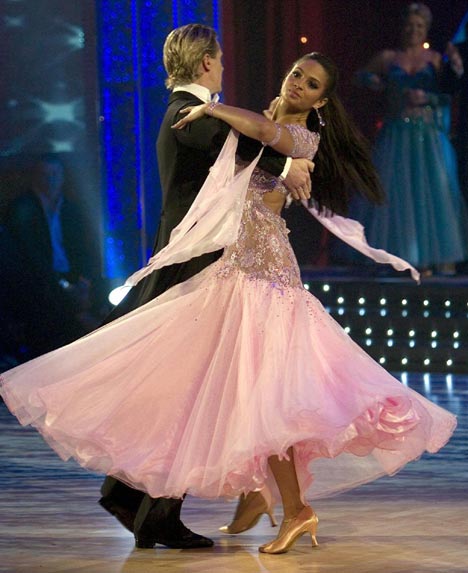 This is a fast European ballroom dance with a barely noticeable rise and fall. A simple and elegant rotational movement characterizes the Viennese waltz. This dance, according to most students of dance schools, is considered one of the most difficult in teaching dances.
This is a fast European ballroom dance with a barely noticeable rise and fall. A simple and elegant rotational movement characterizes the Viennese waltz. This dance, according to most students of dance schools, is considered one of the most difficult in teaching dances.
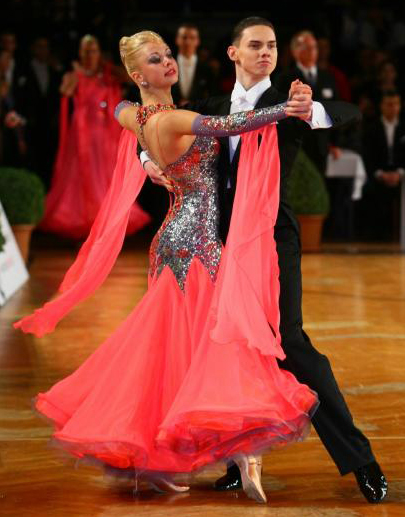 Tango is considered one of the most fascinating ballroom dances of the European program. This sensual dance originated in Latin America in the first half of the twentieth century.
Tango is considered one of the most fascinating ballroom dances of the European program. This sensual dance originated in Latin America in the first half of the twentieth century.
Slow foxtrot
 Foxtrot is very similar to a slow waltz, as many waltz figures are played in it. The fundamental difference in rhythm. The main figures dance in the rhythm of "slow, fast, fast." The nature of the steps is moving and smooth, with ups and downs, like a waltz. Dance from the European program.
Foxtrot is very similar to a slow waltz, as many waltz figures are played in it. The fundamental difference in rhythm. The main figures dance in the rhythm of "slow, fast, fast." The nature of the steps is moving and smooth, with ups and downs, like a waltz. Dance from the European program.
Quickstep
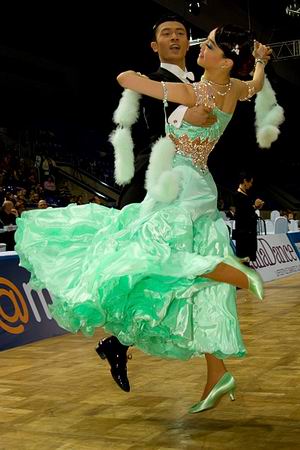 Quickstep is a fast version of slow fox. This is a very fun and rhythmic dance, consisting of very fast steps, syncopated rhythms and runs. Quickstep is interesting to watch, simple figures are not complicated to execute. Therefore, acquaintance with ballroom dancing begins with it. Also applies to European ballroom dancing.
Quickstep is a fast version of slow fox. This is a very fun and rhythmic dance, consisting of very fast steps, syncopated rhythms and runs. Quickstep is interesting to watch, simple figures are not complicated to execute. Therefore, acquaintance with ballroom dancing begins with it. Also applies to European ballroom dancing.
Samba, as one of the most famous Brazilian dances, is popular with young people and the older generation. You can dance samba alone and in pairs.
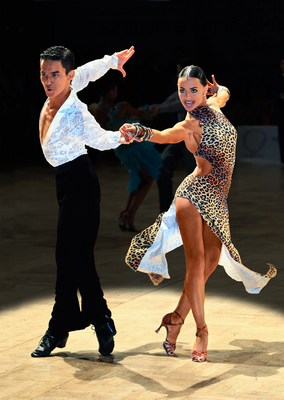 Cha cha cha is one of the five Latin American dance groups. This is a lively, flirtatious dance, filled with passion and energy. The classic “Cuban movements” give the cha cha cha cha a unique style. Partners work in a coordinated and synchronous manner, trying to carry out each movement clearly and beautifully.
Cha cha cha is one of the five Latin American dance groups. This is a lively, flirtatious dance, filled with passion and energy. The classic “Cuban movements” give the cha cha cha cha a unique style. Partners work in a coordinated and synchronous manner, trying to carry out each movement clearly and beautifully.
 According to most, rumba is the most romantic and most sensual dance of the whole group of Latin American dances. Due to its ancient origin, this dance is often called the "grandfather of Latin American dances."
According to most, rumba is the most romantic and most sensual dance of the whole group of Latin American dances. Due to its ancient origin, this dance is often called the "grandfather of Latin American dances."
Paso doble
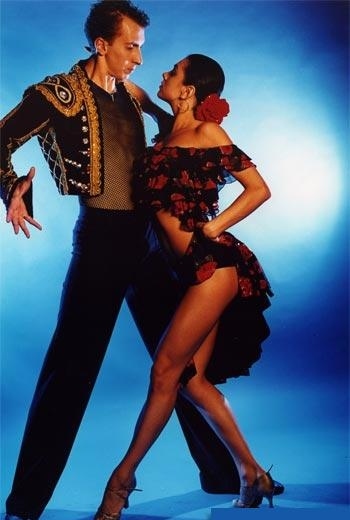 Paso doble is considered one of the most temperamental and lively ballroom dancing. latin American programcreated once in the south of France. This is a kind of fusion of music, drama and the movements of the Spanish bullfighting.
Paso doble is considered one of the most temperamental and lively ballroom dancing. latin American programcreated once in the south of France. This is a kind of fusion of music, drama and the movements of the Spanish bullfighting.


